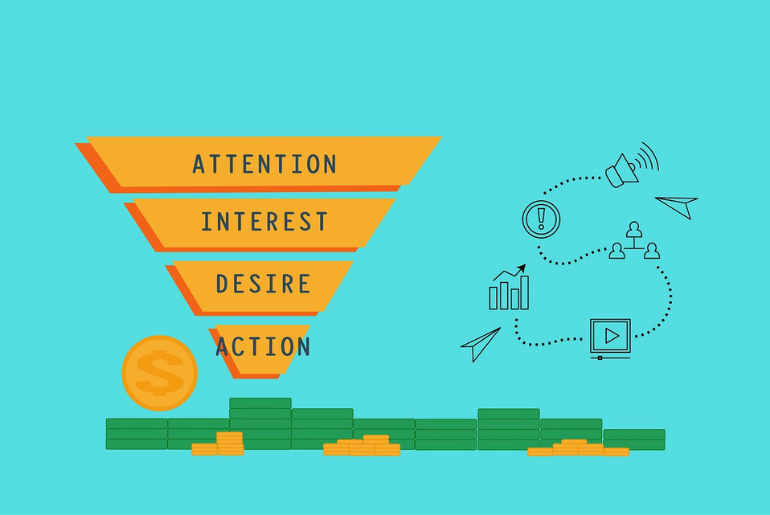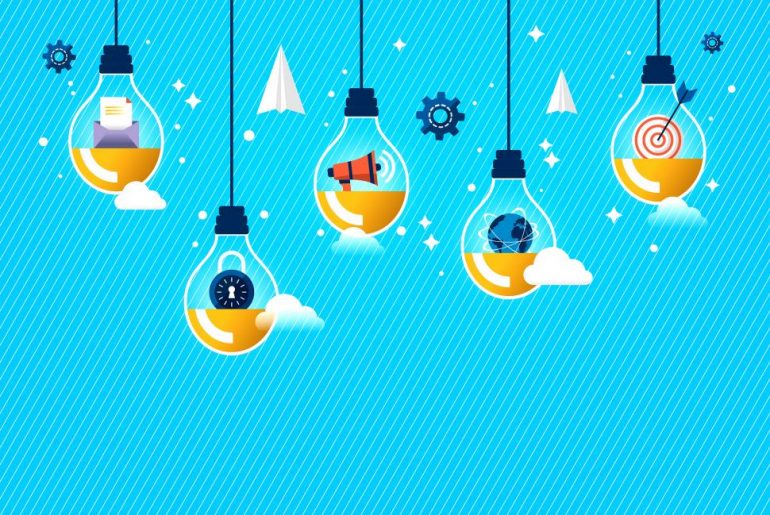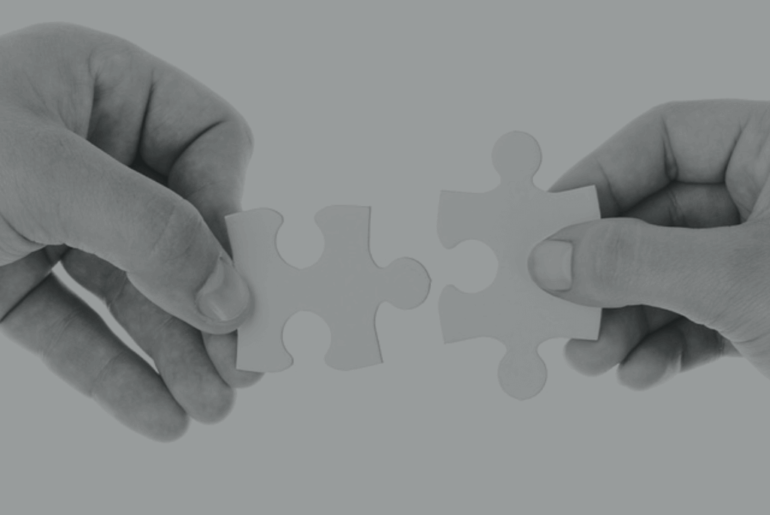
Building a B2B sales funnel is not easy. It takes time, effort, and knowledge to create one that will convert leads into customers. However, it’s worth it when you see the results in your bottom line.
Business-to-business sales are set to expand and evolve steadily in 2023. This industry has already been valued at $7.72 trillion in 2021, and the CAGR is projected to grow by 18.6% from 2021 to 2028.
A sales funnel is the process that most businesses go through when they are trying to convert a potential customer into a paying customer. A sales funnel starts with the acquisition of new leads, then moves on to nurturing those leads until they become customers.
Many sales journeys start by looking at customers as a consistent, organized process, but it seems considerably simpler than expected.
- Simple Explanation of the B2B Sales Funnel
- The 6 Stages Of A Solid B2B Sales Funnel
- Elements Of A B2B Sales Funnel: How To Create One And Why It Matters
- 5 Different Models Of The B2B Sales Funnel: Which One Is Yours?
- 5 Challenges You Will Face When Building Your Sales Funnel
- You need this for your B2B sales funnel
This article will help you in understanding the basics of building a B2B sales funnel. We’ll also discuss some of the best practices for creating an effective funnel that will lead to more conversions and higher profits for your company.
Simple Explanation of the B2B Sales Funnel
The sales funnel is the sequence of steps that a customer takes from becoming aware of your company to eventually making a purchase. It is often visualized as a funnel, with the widest part at the top and narrowing down as you move down the funnel.
There are many different types of sales funnels, but they all have some things in common:
1) A customer becomes aware of your company and its product or service through various marketing channels.
2) The customer then receives an offer that’s compelling enough to prompt them to take action and enter into their first contact with your business.
3) After this first contact, various follow-up steps aim to drive customers towards making a purchase.
The 6 Stages Of A Solid B2B Sales Funnel
This is not a new concept. Ever since the first sales consultants were hired by companies, the sales funnel has been their main customer acquisition strategy. The following are the five classic stages of the B2B sales funnel.
Still Not an User of Aritic PinPoint Automation?
Awareness
The awareness stage is where you introduce your company to potential customers. You may have a marketing team that does this or do it yourself. The goal is to get people to remember your company’s name and see if they’re interested in what you have to offer.
Interest
When you create interest, potential customers will want more information about what you have to offer. That’s why it is known as the interest stage. So they’ll start doing research on your company and what it offers them, and they’ll start asking questions about pricing, delivery times, etc.
Desire
This stage pop-up when the prospective customer starts to want something from you. They’re usually at this stage if they’ve already done research on your products or services and are now looking for a way to buy them.
Intent
This stage actually clears the dust! Intent refers to when someone has made up their mind about buying something from you but needs some help deciding which product or service would be best for them.
Evaluation
The evaluation stage is primed and crucial. This is where a prospect evaluates your product and decides whether it’s worth the time and effort to go through with the purchase.
Action
The last stage is action. This happens when the customer has decided to buy the product or service and has taken some sort of action to do so, such as filling out a form on the company’s website for more information about pricing and availability.
Elements Of A B2B Sales Funnel: How To Create One And Why It Matters
A well-established sales process will help you better understand the process of making a sale. It also enables you to see what is working and what is not to make adjustments when needed.
- Establish a defined sales process
It can be challenging to keep track of all the moving pieces when it comes to sales, but by creating a B2B sales funnel, you can stay on top of what’s going on at all times.
The first step is to come up with a sales process that will work for your company. It involves steps to get everyone on the same page. This will streamline the process and make it easier for you to track your progress.
- Let your salesforce specialize
In order to create a B2B sales funnel, it is important to let your sales team specialize.
This way, they can focus on one or two major topics and provide more specialized services that will be more beneficial to the customer.
The specialist will also better understand the customer’s needs and requirements.
It is a win-win situation for both the company and the customer.
- Bring communication to the core of the process
The prime to creating a B2B sales funnel is to build communication throughout the process. This includes things like social media, email, and phone calls.
The idea is to create a dialogue with the customer that will help them better understand your product and service offerings.
- Monitor your team’s real success
The first step in creating a B2B sales funnel is to monitor the actual success of your team.
There are many ways to do this, but it’s essential that you find one that works for you and your team.
A few examples of monitoring methods are tracking the number of leads generated, the number of meetings set up, or the number of deals closed.
With these metrics in hand, you’ll be able to see how successful your team has been and make adjustments as necessary.
- Keep in touch with your customers
The customer’s purchasing journey is crucial to the success of a business. A successful B2B sales funnel means that it will have a clear path from the initial contact to the sale.
When creating a B2B sales funnel, you need to ensure that you’re following up with customers and seeing what worked and what didn’t during their purchase journey.
You need to make sure that your follow-up process is consistent and structured. This will allow your company to create an effective sales funnel which will lead us to success.
- Keep your process organized
It is crucial to stay organized when you’re working on a B2B sales strategy. When your operational processes are organized, it will be easier for you to keep track of your leads, your pipeline full, and your sales numbers high.
Here are some tips for staying organized:
-Leverage a CRM system that will help you stay on top of your leads and their progress
-Build a pipeline map that will show where your prospects are in the sales process
-Create a lead scoring system so that you can prioritize your leads
Execute Effective Marketing Automation Workflows Now
5 Different Models Of The B2B Sales Funnel: Which One Is Yours?
Every business owner knows sales are the driving force behind their business. As such, it is important that you continually explore new ways to generate more sales. One way to do this is to examine the different models of the B2B Sales Funnel. Here are some examples of a B2B sales funnel and how it can be used for your business.
I. The AIDA Model
The AIDA model is the oldest and most popular model in B2B marketing. AIDA stands for Attention, Interest, Desire, and Action.
This model was created by E. St Elmo Lewis in 1898 as a way to help businesses generate more sales through advertising. This model has been used as a marketing tool for many years because it is simple and easy to understand. It also provides a clear path for marketers to follow when trying to sell their products or services.
It consists of four steps:
1) Awareness stage: You want to make sure that, when people first come across your business, they are aware of what it is and what it offers.
2) Interest stage: Once they know about your company, you need to get them interested in what you have to offer.
3) Desire stage: This stage involves encouraging prospects to see if their desired outcome will happen if they take the next action.
4) Action stage: Once they are interested, encourage them to take action by clicking on your ad or website link or filling out a form.
These steps are designed to work together to influence prospects and lead them to take action, whether making a purchase or requesting more information about your product or service.
II. The Forrester’s Model
The Forrester’s Model of the B2B Sales Funnel is the most popular and widely used model in the industry. It was developed by Forrester Research to help companies understand how their customers buy.
The model has five stages that are connected with each other: Awareness, Consideration, Trial, Purchase, and Loyalty.
-The first stage is the Awareness stage, where the customer realizes that they have a need for your product or service.
-The second stage is the Consideration Stage, where they are evaluating whether they should buy from you or not.
-The third stage is the Trial Stage, where they test your product or service and compare it to other solutions on the market.
-The fourth stage is the Purchase Stage, which means that they have already bought your product or service and are satisfied with it.
-And finally, there’s the Loyalty Stage, which means that they have a considerable desire to remain repeating customers, which ultimately amp up the bid to retain the customers.
A McKinsey study found that 75% of B2B buyers want to talk to sales reps before making a purchase. However, only 15% of the repeat buyers need to talk to the sellers.
III. McKinsey’s Loyalty Loop
McKinsey’s Loyalty Loop is a sales funnel used to convert customers into repeat purchases. McKinsey’s Loyalty Loop has these three stages:
1) Trigger
2) Action
3) Loyalty
The first stage, the “trigger,” is the point in time when the customer decides to buy something from your business.
This could be because of an advertisement they see on Facebook or because they decided they want to buy one of your products during their daily commute. Once this customer takes action and buys something, they are at the “action” stage.
If you reach out to them after they make a purchase, this will help create loyalty for your company. They are more likely to come back for another purchase if you reach out and show them that you care about their opinion of your business.
There are five ways of how businesses can follow up with customers after purchase: email, print marketing material, phone calls, social media posts, or mail marketing materials.
The final stage is loyalty, where the customer continues to come back for more purchases because this new product meets their needs. The key to McKinsey’s Loyalty Loop is focusing on what makes this customer happy so that they keep coming back for more purchases in the future.
IV. The Conversion Funnel
The Conversion Funnel is a common approach in the B2B world. This is because it’s more straightforward to understand than many other models. It breaks down the sales process into five stages: awareness, desire, action, and profit.
Awareness stage is when prospects are first introduced to your business. After that, interest occurs when they want to know more about what you offer.
Desire stage happens when they’re ready to purchase your product or service.
Action stage is when the lead takes the desired action of purchasing your product after meeting with one of your sales representatives.
And finally,
Profit stage is made up of all the different ways your company can earn money off of this customer after purchasing your product or service.
V. RAIN Group’s Buying Process
The RAIN Group buying process model is holistic and customer-centric to the B2B sales funnel. They incorporate both the buying process perspective and selling process perspective head-to-head that can help companies at any point in the buying process.
The RAIN Group’s Buying Process:
1) Research: The buyers research all their options and gather information about their industry’s top products and services.
2) Assess: The buyers assess what they need, what they want, and what they can afford.
3) Compare: The buyers compare different offers from different vendors to make an informed decision.
4) Commit: The buyers commit to one vendor and purchase their product or service.
5 Challenges You Will Face When Building Your Sales Funnel
How many times have you read through the sales funnel process, only to feel overwhelmed and confused? It’s confusing because it is! Many software platforms can integrate with your existing website or app. However, how do you ensure that your users know where they are in the process? How do you get them to take action at every step of the way?
“Sales funnels aren’t just about taking your customer’s money—they’re about building relationships with them and helping them achieve their goals.”
Businesses’ most significant challenge when building sales funnels is getting too hung up on the technical details. So here we talk about a few challenges of building a solid sales funnel!
- Drive more leads
It’s not enough to just build a sales funnel. Once you have one, you actually need to get people into it! That can be a challenge in itself, especially if your leads don’t know who you are or what you do. Sales funnels are a great way to boost revenue, but they’re not always easy to build. They take time and effort.
Lead generation helps you send more leads through your sales funnel, so there is a greater chance you have at closing them and turning them into customers. The problem is that this can be slow work. But there are so many ways to generate more leads using automation platforms and omnichannel strategy!
- Creating content that converts
It used to be that it was enough to have a great product, and the sales would follow. But now, in order to succeed with your online business, you need to create an entire funnel of content designed to draw potential customers through their journey toward purchase.
It requires you to think about your audience’s wants and needs and how to deliver your message so that information can be easily absorbed. Of course, this is easier said than done. Your challenge is how do you build a compelling sales funnel without spending an arm and a leg?
- Getting ahead of the market noise
Marketing has long been a challenging field. Older tools of the trade like paper ads and direct mail campaigns have proven ineffective in today’s fast-paced digital world, where customers are bombarded with information at every turn.
That’s why building a sustainable sales funnel is one of the most crucial aspects of any business. Not only do you have to build an effective marketing strategy, but you also have to figure out how to get that campaign noticed amidst all the noise in the market.
- Shortening the sales cycle
One of the biggest challenges that companies face when trying to get their products/services in front of customers is how long it takes to close a sale. It’s not uncommon for larger companies to have sales cycles that last anywhere from six months to two years. Unfortunately, small and medium-sized businesses don’t have the luxury of having a long sales cycle.
That’s why it is essential to minimize the number of steps between lead capture and conversion. One way to do this is by reducing the sales cycle, which refers to the average time it takes to move through each stage of your funnel. By eliminating unnecessary steps and making your sales process more streamlined, you can shorten the sales cycle while improving lead-to-customer conversion rates at the same time!
- Monitoring performance metrics with accuracy
When it comes to building a sales funnel, tracking is of utmost importance. You need to know who’s looking at what and when they’re doing it so you can make smart decisions as you move forward with your business.
The more sales funnels you build, the more likely you will experience this kind of problem. That’s why it’s always good practice to make sure your analytics are set up correctly.
You need this for your B2B sales funnel
In the beginning, it may seem like a daunting task to build a B2B sales funnel from scratch. However, once you start breaking down each step, it starts to feel less overwhelming. By following these 7 simple steps outlined above, you too can create your own successful B2B sales funnel and start bringing in more leads for your business!
Do remember that there are many things you can do to build a B2B sales funnel, but if you’re interested in seeing specific examples of how this can be done, feel free to schedule a time to speak with one of our expert consultants. It doesn’t matter what industry you’re in or which software platform you currently use, we can help make your sales process more effective by building an effective funnel.



